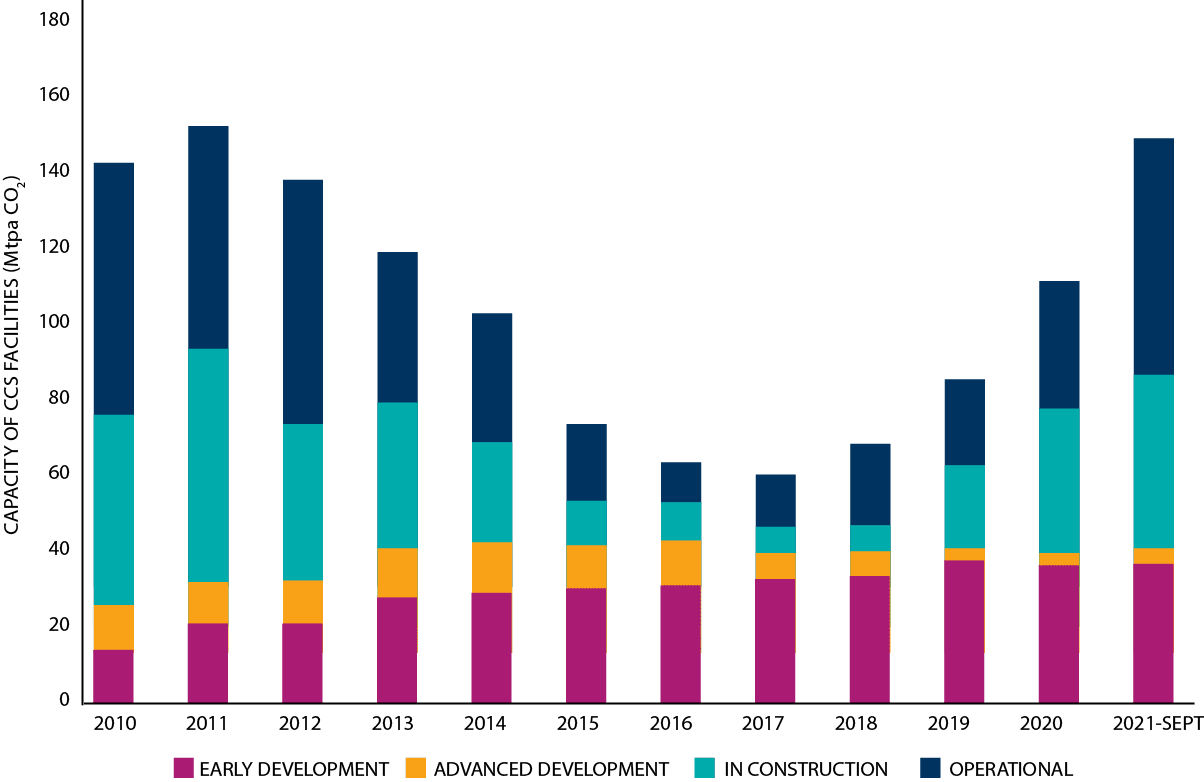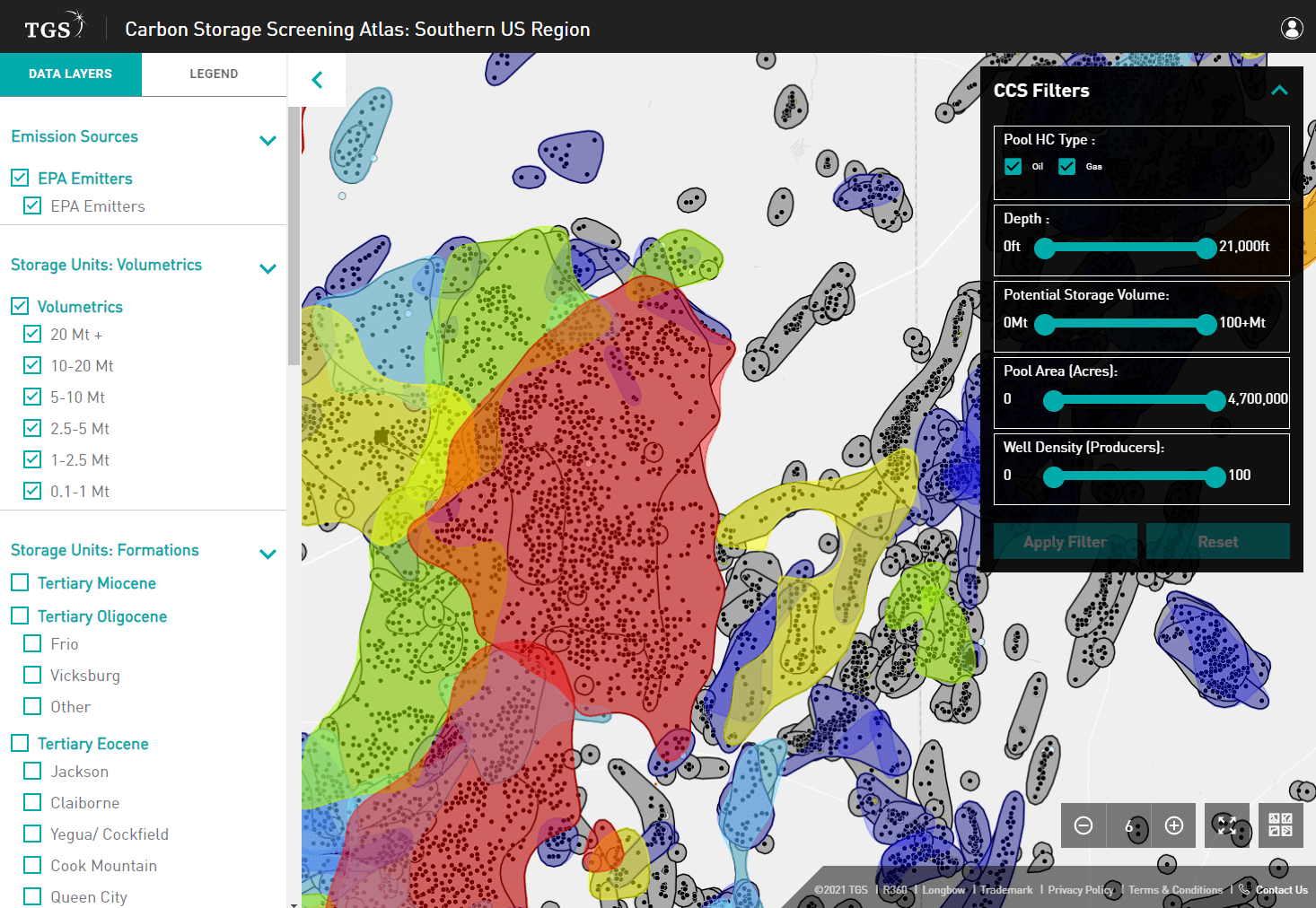| TGS insights give you the stories behind Energy data. These regular short 3-5 minute reads feature thought-provoking content to illustrate the use of energy data in providing insight, nurturing innovation, and achieving success. |
As the world strives toward a net-zero emissions standard, the International Energy Agency (IEA) estimates that clean energy investment will have to more than triple by 2030 to $4 trillion dollars, and many pioneering technologies will have to come to fruition. But there are crucial elements in the CCS toolbox that have been around for some time.
One key area of development that will help achieve the net-zero goal during the energy transition era is the ongoing advance in carbon capture and storage (CCS), also referred to as carbon capture, utilization, and storage (CCUS) technologies. Many industries and government stakeholders are finding new ways to reduce and offset CO2 emissions without disrupting the global economy by raising energy costs or hindering current global production or transportation capabilities. As a result, some believe that CCS and CCUS technologies will be necessary to meet global initiatives as part of the energy transition, building new avenues for investment and economic growth while reducing greenhouse gas emission.
 |
Join the ConversationAt TGS we create unique, actionable insights from raw energy data. These insights can reduce risks and enable a more detailed understanding of natural resource investments. Follow us to #SeeTheEnergy and JOIN THE CONVERSATION >> |
Current Large Emitters
According to the EPA, the biggest CO2 emitters are electricity and heat production industries which account for 25% of the total greenhouse gas emissions, followed by agriculture at 24%, and large industries, including chemical and cement factories, at 21%. Transportation emissions from air, land, marine, and rail account for 14%.
Of these industries, only the Oil and Gas production sector has developed a viable and extensive use for CO2, using the gas for enhanced oil recovery (EOR). EOR technologies using CO2 have been in commercial use since the 1970s and over the past five decades, O&G operators have become adept at utilizing CO2 to enhance productivity. Currently, 20% of all wells globally use this method.
Government tax credits and looming regulations incentivize power plants and manufacturing industries to find ways to capture and utilize their CO2 emissions to meet net-zero targets. In addition, the ability to turn CO2, an emissions byproduct, into an investment that can add to capital without posing a cost to consumers is the best incentive for many industries to participate in actively reaching the net-zero mandates.
CCS Facilities and Storage
According to the Global CCS Institute, there are 27 operational CCS facilities worldwide that have a capture capacity of 36.6 Mtpa (Million tons per annum). Over half of these are in North America. An additional 106 facilities are in development or under construction and will provide an additional 112 Mtpa of capture capacity by 2030. In the first nine months of 2021, 71 projects began development, doubling the number of projects from the previous year.
These facilities offer a variety of solutions to various industrial endeavors that contribute to their CCS strategies. In general, they all have a method for capturing and separating the CO2 from other gasses, compressing and transporting the captured CO2, and finally storing and/or utilizing it.
The Department of Energy estimates that the US has a storage capacity of 2.6-22 trillion tons of CO2. The ideal storage locations are in naturally occurring geologic formations that have a proven ability to store liquids and gas. Many of the same formations have been targets for hydrocarbon production and are ideal for CO2 storage. Additionally, deep saline reservoirs and basalt reservoirs are being investigated as additional options for CO2 storage.
 Graph showing the pipeline of commercial CCS facilities from 2010 to September 2021 by Capture Capacity [from GCCSI]
Graph showing the pipeline of commercial CCS facilities from 2010 to September 2021 by Capture Capacity [from GCCSI]
Technology to Advance CCS Endeavors
Finding opportunities for manufacturing and power-creating industries to offset their CO2 emissions profitably is a challenge. Specialists in carbon capture can assist in the logistics of collecting emissions, but physical constraints must be considered when determining storage opportunities – where does the carbon go? Thankfully, companies traditionally involved in oil and gas operations have actively developed CCS technologies and collected data to advance CCS for decades. Their extensive knowledge of the subsurface will play a valuable role in determining new carbon storage solutions and options.
The question of carbon storage opportunities for local-scale emitters is one that companies like Canadian Discovery and TGS hope to answer. They have collaborated to create a new subsurface classification dataset designed as a prospecting and technical assessment tool for potential CO2 storage in depleted reservoirs. This unique screening tool is accessed via a web-based interface and allows companies and investors to assess the economics and viability of their sequestration solutions. In addition to broader regional assessment, crucially, the tool is equally valuable on a local scale in assisting CO2 emitting industries who need to scope possible CO2 sequestration options and economic scenarios in proximity to their operations.
Data types include geologic formations and storage availability, current CO2 pipelines and utilization operations, and large industrial emitters. With access to decades of geological knowledge in addition to information delineating the proximity of large emitters to ideal storage sites, companies like TGS hope to provide industry with data to reduce or offset their carbon emissions and maximize their resultant tax efficiencies. These tools give industry the opportunity to build scalable solutions that can grow with technology as additional profitable avenues for CO2 capture, storage and utilization become available.
 TGS has developed a subsurface classification dataset delivered within a web-based app as a prospecting and technical assessment tool for potential CO2 storage.
TGS has developed a subsurface classification dataset delivered within a web-based app as a prospecting and technical assessment tool for potential CO2 storage.
For more information on the carbon storage screening tool offered by TGS in the Southern US, please visit the following web page: https://www.tgs.com/carbon-capture-and-storage/storage-prospecting
Sources:
- Global CCS Institute, 2021 Status Report:
https://www.globalccsinstitute.com - Nunez-Lopez, V., and Moskal, E., 2019. Potential of CO2-EOR for Near Team Decarbonization. Frontiers in Climate. https://doi.org/10.3389/fclim.2019.00005
- Jones, A.C., and Lawson, A.J., 2021. Carbon Capture and Sequestration (CCS) in the United States. Congressional Research Service. https://crsreports.congress.gov/product/pdf/R/R44902

